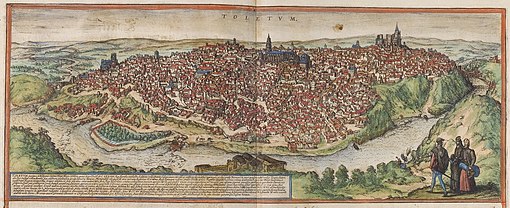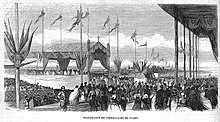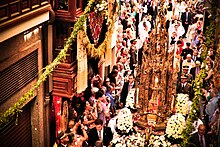Toledo (UK: /tɒˈleɪdoʊ/ tol-AY-doh,[3] Spanish: [toˈleðo] (![]() listen)) is a city and municipality of Spain, capital of the province of Toledo and the de jure seat of the government and parliament of the autonomous community of Castilla–La Mancha. Toledo was declared a World Heritage Site by UNESCO in 1986 for its extensive monumental and cultural heritage.
listen)) is a city and municipality of Spain, capital of the province of Toledo and the de jure seat of the government and parliament of the autonomous community of Castilla–La Mancha. Toledo was declared a World Heritage Site by UNESCO in 1986 for its extensive monumental and cultural heritage.
Located on the banks of the Tagus in central Iberia, Toledo is known as the "City of the Three Cultures" for the cultural influences of Christians, Muslims, and Jews throughout its history. It was the capital, from 542 to 725 CE, of the Visigothic kingdom, which followed the fall of the Roman Empire. Toledo was also the location of historic events such as the Councils of Toledo and was labelled the "Imperial City" due to the fact that it was the main venue of the court of Charles V, Holy Roman Emperor in Spain. The city, seat of a powerful archdiocese for much of its history, has a Gothic Cathedral, the Catedral Primada de España ("The Primate Cathedral of Spain"), and a long history in the production of bladed weapons, which are now common souvenirs of the city.
As of 2015, the municipality had a population of 83,226.[4] The municipality has an area of 232.1 km2 (89.6 sq mi).
Toledo | |
|---|---|
 Toledo and the Tagus River | |
| Nickname(s): La ciudad imperial (The Imperial City) and Ciudad de las Tres Culturas (City of the Three Cultures) | |
| Coordinates: 39°51′24″N 4°1′28″WCoordinates: 39°51′24″N 4°1′28″W | |
| Country | Spain |
| Autonomous Community | Castile–La Mancha |
| Province | Toledo |
| Settled | Pre-Roman |
| Government | |
| • Mayor | Milagros Tolón (PSOE) |
| Area | |
| • Land | 232.1 km2 (89.6 sq mi) |
| Elevation | 529 m (1,736 ft) |
| Population (2018)[2] | |
| • Total | 85,085[1] |
| • Density | 359.58/km2 (931.3/sq mi) |
| Postcodes | 45001–45009 |
| Area code | +34 925 |
| Website | toledo |
 | |
| Official name | Historic City of Toledo |
| Criteria | Cultural: i, ii, iii, iv |
| Reference | 379 |
| Inscription | 1986 (10th Session) |
| Area | 259.85 ha |
| Buffer zone | 7,669.28 ha |
Toledo (UK: /tɒˈleɪdoʊ/ tol-AY-doh,[3] Spanish: [toˈleðo] (![]() listen)) is a city and municipality of Spain, capital of the province of Toledo and the de jure seat of the government and parliament of the autonomous community of Castilla–La Mancha. Toledo was declared a World Heritage Site by UNESCO in 1986 for its extensive monumental and cultural heritage.
listen)) is a city and municipality of Spain, capital of the province of Toledo and the de jure seat of the government and parliament of the autonomous community of Castilla–La Mancha. Toledo was declared a World Heritage Site by UNESCO in 1986 for its extensive monumental and cultural heritage.
Located on the banks of the Tagus in central Iberia, Toledo is known as the "City of the Three Cultures" for the cultural influences of Christians, Muslims, and Jews throughout its history. It was the capital, from 542 to 725 CE, of the Visigothic kingdom, which followed the fall of the Roman Empire. Toledo was also the location of historic events such as the Councils of Toledo and was labelled the "Imperial City" due to the fact that it was the main venue of the court of Charles V, Holy Roman Emperor in Spain. The city, seat of a powerful archdiocese for much of its history, has a Gothic Cathedral, the Catedral Primada de España ("The Primate Cathedral of Spain"), and a long history in the production of bladed weapons, which are now common souvenirs of the city.
As of 2015, the municipality had a population of 83,226.[4] The municipality has an area of 232.1 km2 (89.6 sq mi).
Coat of arms[edit]
The town was granted arms in the 16th century, which by special royal privilege was based on the royal of arms of Spain.
History[edit]
Roman era and Late Antiquity[edit]
Toledo (Latin: Toletum) is mentioned by the Roman historian Livy (ca. 59 BCE – 17 CE) as urbs parva, sed loco munita ("a small city, but fortified by location"). Roman general Marcus Fulvius Nobilior fought a battle near the city in 193 BCE against a confederation of Celtic tribes; defeating them and capturing a king called Hilermus.[5][6] At that time, Toletum was a city of the Carpetani tribe, and part of the region of Carpetania.[7] It was incorporated into the Roman Empire as a civitas stipendiaria, (a tributary city of non-citizens) and later a municipium.[8] With this status, city officials obtained Roman citizenship for public service, and the forms of Roman law and politics were increasingly adopted.[9] At approximately this time, a Roman circus, city walls, public baths, and a municipal water supply and storage system were constructed in Toletum.[10]
The Roman circus in Toledo was one of the largest in Hispania. The circus could hold up to 15,000 spectators. A fragmentary stone inscription records circus games paid for by a citizen of unknown name to celebrate his achieving the sevirate, a kind of priesthood conferring high status.[10] Games were held in the circus late into the 4th and early 5th centuries, an indication of active city life and ongoing patronage by wealthy elites.[11]
Toledo started to gain importance in late antiquity. There are indications that large private houses (domus) within the city walls were enlarged, while several large villas were built north of the city through the 3rd and 4th centuries.[12] A church council was held in Toledo in the year 400 and 527 to discuss the conflict with Priscillianism.[13] Already since 546 (possibly earlier), Visigoth rulers installed the capital of their kingdom in Toledo.[14] King Theudis was in Toledo in 546, where he promulgated a law.[15]
Throughout the 7th century, a series of church councils—the so-called Councils of Toledo—discussed on the theological reconciliations on Nicene Christianity; they were held in Toledo under the Visigoths.[16] By the end of the 7th century the bishop of Toledo was the leader of all other bishops in Hispania, a situation unusual in Europe. It was also unmatched as a symbolic center of monarchy.[17][18]
When internal divisions developed under the Visigothic nobles, Tariq bin Ziyad captured Toledo in 711 or 712,[19] on behalf of the Umayyad Caliphate of Damascus, as part of the Islamic conquest of the Iberian Peninsula. Tariq's superior, Governor Musa disembarked in Cádiz and proceeded to Toledo, where he executed the Visigothic nobles, destroying much of the existing power structure.[20][21]
Middle Ages[edit]
In the wake of the Umayyad conquest, "Toledo suffered a period of profound decline throughout much of the earlier centuries of Arab dominance in the peninsula."[22]
The invaders were ethnically diverse, and available evidence suggests that in the area of Toledo (locally known as Ṭulayṭulah under Islamic rule), Berber settlement predominated over Arab.[23] In 742 the Berbers in Al-Andalus rebelled against the Arab Umayyad governors. They took control of the north and laid an unsuccessful siege on Toledo.[24]
Toledo retained its importance as a literary and ecclesiastical centre well into the mid-8th century; as demonstrated by the Chronicle of 754.[25] During this period, several letters show of the primacy that the church of Toledo held.[n. 1]
Under the Umayyad Emirate of Cordoba, Toledo was the centre of numerous insurrections against Cordobese government dating from 761 to 857.[27][28] Girbib ibn-Abdallah, a poet from Toledo wrote verses against the Umayyads, helping to inspire a revolt in Toledo against the new emir in 797.[29][30] By the end of the 8th century, the Umayyads had made Toledo the administrative center of the Central March of Al-Andalus.[31] In 852, a new revolt broke out in Toledo. The Umayyad governor was held hostage in order to secure the return of Toledan hostages held in Córdoba. In reprisal of a prior attack by Toledans, emir Muhammad I sent an army to attack the Toledans, but was defeated. Toledo forged an alliance with King Ordoño I of Asturias. They fought together at the Battle of Guadacelete but lost. Later in 857, the Toledans attacked Talavera but were again defeated. In 859, Muhammad I negotiated a truce with Toledo. The city became virtually independent for twenty years, though locked in conflict with neighboring cities. Cordobese authorities re-asserted control over Toledo in 873, after the successful Umayyad siege on the city, which forced defenders to submit.[32][33][34] The Banu Qasi gained nominal control of the city until 920. Following a new period of unruliness in the 920 and 930s,[35] Caliph Abd-ar-Rahman III captured the city in 932, following an extensive siege.[36]
In the wake of the early 11th-century Fitna of al-Andalus, Toledo became the centre of an independent polity, the so-called Taifa of Toledo, under the rule of the Dhu l-Nunids.[37] The population of Toledo at this time was about 28,000, including a Jewish population of 4,000.[38] The Mozarab community had its own Christian bishop. The taifa was centered on the Tajo River and bordered Sierra de Guadarrama, Guadalajara, Medinaceli, the Taifa of Valencia and the Mountains of Toledo.[39]
The taifa fell in political disarray, owing to the economic draining caused by the parias (tributes) imposed by the kingdom of León as well as territorial mutilations, and so a revolt erupted in 1079, which was followed by the Aftasid ruler of Badajoz taking control of the city.[40]
On 25 May 1085, Alfonso VI of León took Toledo and established direct personal control over the city from which he had been exacting tribute. Upon that time, the city's demographics featured a heterogeneous composition, with both Mozarabs, Muslims and Jewish communities, to which incoming Christians from northern Iberia and Frankish elements added up, so, initially, different fueros were simultaneously in force for each community.[41] After the Christian conquest, the city's Mozarab community grew by immigration from the Muslim south.[42]
Toledo preserved its status as a cultural centre; and a tag-team translation centre was established in which books in Arabic or Hebrew would be translated into Castilian by Muslim and Jewish scholars, and from Castilian into Latin by Castilian scholars, thus letting long-lost knowledge spread through Christian Europe again. Under the Roman Catholic Archdiocese of Toledo multiple persecutions (633, 653, 693) and stake burnings of Jews (638 CE) occurred; the Kingdom of Toledo followed up on this tradition (1368, 1391, 1449, 1486–1490 CE) including forced conversions and mass murder and the rioting and blood bath against the Jews of Toledo (1212 CE).[43][44]
Modern era[edit]
During the persecution of the Jews in the late 15th and early 16th centuries, members of the Jewish community of Toledo produced texts on their long history in Toledo.[citation needed] After the crushing of the Revolt of the Comuneros, Charles V's court was installed in Toledo, with the monarch choosing the city as his residence at least 15 times from 1525 on.[45] Charles granted the city a coat of arms.[45] From 1528 to 1561 the population increased from 31,930 to 56,270.[45] In 1561, during the first years of his son Philip II's reign, the Royal Court was set in Madrid.
The archbishops of Toledo remained as powerful brokers in the political and religious affairs of Spain for the rest of the Ancien Régime,[46] also owning an extensive seigneurial land across most of the southern half of the Inner Plateau and some nearing territories.[47]
The mass arrival of deported unruly moriscos from Granada ('moriscos nuevos') in Toledo and its lands (6,000 arrived to the city only, at least temporarily)[48] in the wake of the Alpujarras rebellion posed a formidable logistic challenge, and the uneasy preexisting system of social relations between the moros viejos ('old moors') and the old christians was disrupted.[49] By and large, Granadan new moriscos were subject to xenophobic abuse and became stigmatised as bloodthirsty and sacrilegious.[50]
The city excelled in silk manufacturing during the Early Modern Period. The silk industry reached a peak in the 16th century, entering a protracted decline in the later years of that century and ultimately disappearing by the turn of the 19th century.[51]
The Peninsular War affected the city in a very negative way.[52] Over the course of the 19th century, Toledo underwent a progressive change from convent-city to bureaucratic city.[53] Being a city quite impervious to external influence at the time, Bourgeoisie exerted a limited influence.[54]
Following the exclusion of Toledo from the railway to the Portuguese border in the 1850s, a project of railway connection from Castillejo to Toledo lobbied by the Marquis of Salamanca was passed in June 1856.[55] The line was opened on 12 June 1858.[56] A budding tourism activity fostered by the arrival of rail contributed to the development of the hospitality industry in the late 19th century.[57] By the turn of the 20th century, Toledo's population stood at about 23,000 inhabitants.[58] The neighborhood of Santa Bárbara came into existence after the arrival of rail.[59]
Following the July 1936 coup d'etat in Spain, the acting military commander in Toledo, José Moscardó, refused to provide weapons to Madrid and hid instead in the alcázar with a garrison of about 1,000 rebels, food, ammunition and some hostages.[60] After 21 July, they became subject to an unsuccessful siege by forces loyal to the Republic during the early stages of the Spanish Civil War.[61] Leading rebel general (and soon-to-be "caudillo") Francisco Franco and his Army of Africa took a detour from their advance towards Madrid (that gave time to the Republicans to build up the defenses in Madrid and receive early foreign support) and lifted the siege of the alcázar in late September 1936.[62] The two months of resistance of the garrisoned rebel military would become a core symbolical feature of the mythology built around the Francoist regime and its ideology.[63]
By 1950, the population stood at 40,243.[64] Urban planning vis-à-vis the development of the neighborhoods of Palomarejos and Polígono ensued in the second half of the 20th century.[64]
In the 1980s, in the context of the creation of the autonomous communities in Spain, Toledo became the de facto capital of the autonomous community of Castilla–La Mancha, hosting the seat of the Cortes of Castilla–La Mancha (the regional legislature) and the presidency of the regional government (the executive).
Holidays[edit]
The Virgen del Valle pilgrimage is celebrated on May 1 at the Ermita de la Virgen del Valle, with a concentration popular holiday in that place.[citation needed] The Holy Week, declared of National Tourist Interest, is held in spring with various processions, highlighting those that take place on Good Friday, and religious and cultural events.[citation needed] The local feast of the Corpus Christi enjoys the status of celebration of International Tourist Interest since 1980.[80] It was conventionally celebrated 60 days after the Sunday of Resurrection.[81] The celebration of the feasts on the part of the Catholic Church had its heyday during the Baroque, post-Trent period.[82] A processional cortege travels around two kilometres (1.2 miles) of streets and richly decorated awnings.[citation needed] The Virgen del Sagrario is celebrated on 15 August, in honour of the Virgen del Sagrario, featuring a procession inside the Cathedral and drinking water of the Virgin in jars.[citation needed]
Main sights[edit]
The city of Toledo was declared a Historic-Artistic Site in 1940, UNESCO later

















沒有留言:
張貼留言